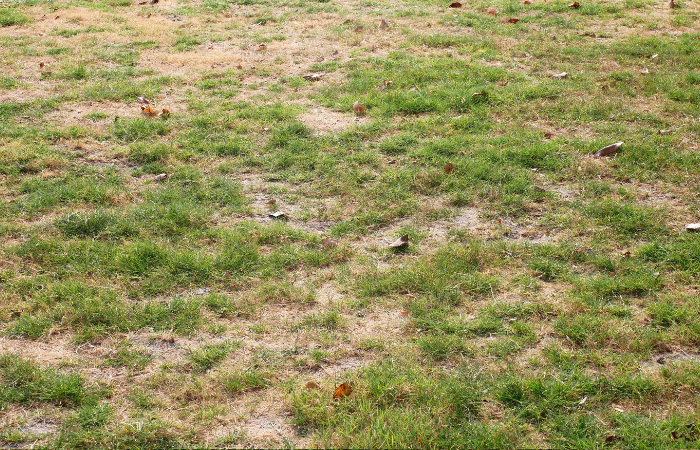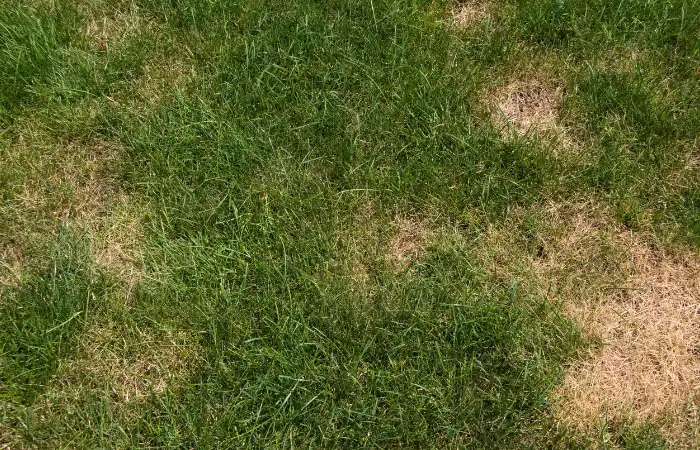Maintaining a lush green lawn in Greater Portland, ME, comes with its fair share of challenges. From unpredictable weather patterns to soil variations, homeowners often find themselves grappling with common lawn problems. The struggle against stubborn weeds, patchy growth, and brown spots can be all too familiar.
In this article, we’ll explore practical and accessible solutions to address these issues. Whether you’re a seasoned gardener or just beginning, understanding and overcoming these challenges will help you achieve a vibrant and healthy lawn that thrives in the unique conditions of the Greater Portland area.
10 Common Lawn Problems and Their Solutions
1. Powdery Mildew
Powdery mildew is a fungal infection that frequently plagues lawns. Recognized by its white, powdery substance on grass blades, it obstructs photosynthesis and induces yellowing. Combating powdery mildew involves ensuring proper air circulation by pruning overhanging branches and selecting mildew-resistant grass varieties. Early-season fungicide application also proves effective in preventing its rampant spread, ensuring a lush and vibrant lawn.
2. Brown Patch
Brown patch, caused by the Rhizoctonia fungus, is a prevalent lawn issue. It manifests as circular, brown patches, adversely affecting the visual appeal of lawns. Enhancing air circulation, avoiding overwatering, and employing fungicides as a preemptive measure can help manage brown patches. Watering in the morning to facilitate rapid grass drying is an additional practical step in mitigating the impact of this fungal intrusion.
3. Dollar Spot
Dollar spot, a fungal disease yielding small, round, straw-colored patches, is a common concern for lawns. Thriving in humid conditions, preventative measures include improving soil drainage, maintaining appropriate mowing heights, and refraining from excessive nitrogen fertilization. The timely application of fungicides during the early stages is pivotal for effective dollar spot control, ensuring a resilient and healthy lawn.
4. Snow Mold
Another common lawn problem is Snow mold, occurring in cold and wet conditions, frequently affects lawns, leading to circular patches with pink or grayish hues. Raking leaves in the fall, promoting good drainage, and abstaining from heavy nitrogen fertilization late in the season are proactive steps to prevent snow mold. The application of fungicides in late fall or early spring is essential for controlling and minimizing the impact of this fungal affliction.
5. Pythium
Pythium, commonly known as “Pythium blight,” is a lawn disease thriving in warm and humid conditions. This pathogen results in dark, slimy patches on grass and can be managed by improving drainage, avoiding excessive watering, and enhancing soil aeration. Early identification is crucial for effective control, and the application of fungicides is recommended during the early stages of Pythium infestation.
6. Red Thread
Red thread, a fungal disease causing reddish or pinkish threads on grass blades, is often associated with nutrient deficiencies and moist conditions. Elevating nitrogen levels through fertilization, improving lawn aeration, and refraining from evening watering are effective preventive measures. For severe infestations, the application of fungicides becomes necessary to mitigate the impact of red thread and restore the health of the lawn.
7. White Grubs
White grubs, the larvae of various beetles, pose a threat to lawns by feeding on grassroots and creating brown patches. Control measures involve applying nematodes or insecticides to limit white grub populations. Maintaining a healthy lawn through proper irrigation practices and aeration also aids in preventing infestations of white grubs, preserving the lushness of the grass.
8. Chinch Bugs
Chinch bugs, small insects that extract sap from grass, can cause yellowing and dead patches. Invasive in nature, these bugs can be controlled by adhering to proper watering and fertilization practices, as a healthy lawn is more resistant to chinch bug infestations. Insecticidal treatments become necessary in the event of a significant outbreak, ensuring the sustained well-being of the lawn.
9. Crabgrass
Crabgrass, an invasive weed, commonly thrives in bare or thin areas of lawns. Utilizing pre-emergent herbicides during the spring is an effective strategy for preventing crabgrass germination. Sustaining a dense and healthy lawn through proper mowing and fertilization further inhibits the growth of crabgrass, preserving the uniformity and lush appearance of the grass.
10. Dog Damage
Dog damage, often characterized by yellow spots and patches on lawns caused by urine, is a common issue in areas with pet ownership. Diluting pet urine by promptly watering affected areas is a practical solution. Training pets to use a designated area and encouraging increased water intake can help reduce the nitrogen concentration in their urine, minimizing the impact of dog damage on the lawn and preserving its overall health and aesthetic appeal.
Frequently Asked Questions

What type of grass does Maine have?
Maine’s native turf grass is primarily red fescue, known for rapid turf formation. Additionally, Chewings fescue and hard fescue, both bunch-type grasses, are found in the region. While red fescue quickly forms a solid turf, Chewings, and hard fescue take more time to knit together.
How do I know if my grass has fungus?
Signs of grass fungus include discolored or dying patches, varying from yellow to brown. Look for circular or irregular spots, fuzzy, powdery, or slimy growth on grass blades, and rings or arcs of mushrooms. Identifying these symptoms can help determine if your grass is affected by fungus. Early detection enables prompt treatment to preserve a healthy lawn.
Will lawn fungus go away on its own?
No, lawn fungus will not go out on its own. If left untreated, the infection can stay and potentially lead to the death of the grass. Timely intervention and appropriate fungicide application are crucial for addressing lawn fungus and preventing further damage.
What happens when you use an excessive amount of fungicide on your lawn?
Applying too much fungicide on your lawn can have detrimental effects. Excessive use may lead to burning of the grass and harm beneficial microbes, negatively impacting soil quality. Always follow product instructions to ensure proper dosage, preventing damage to your lawn and maintaining a healthy balance in the soil ecosystem.
Conclusion
These ten common lawn problems and solutions in Greater Portland, ME, highlight the challenges homeowners face and practical ways to maintain a lush, healthy lawn. From fungal diseases to invasive weeds, understanding and addressing these issues is key to achieving a vibrant and resilient lawn in this unique environment. Stay proactive, follow these tips, and enjoy the beauty of your thriving green space.
If you’re in Greater Portland, Maine, and need expert lawn care solutions, contact us at Audet Enterprises. We understand the region’s unique challenges and can help you achieve a lush, healthy lawn. Let us be your partner in maintaining vibrant outdoor spaces!


